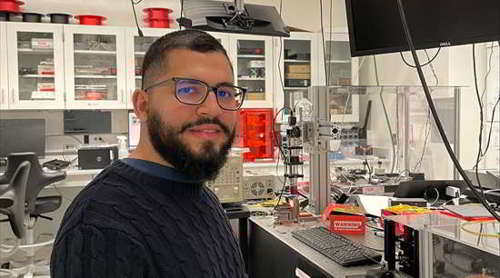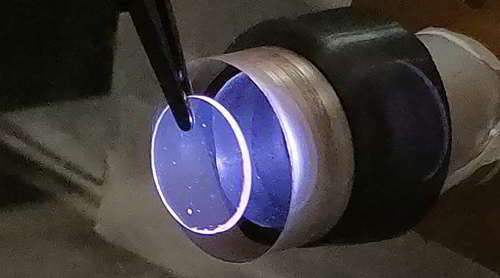From University of Chicago: Terabytes of Data in Millimeter Crystal
UChicago Pritzker Molecular Engineering researchers created a ‘quantum-inspired’ revolution in microelectronics, storing classical computer memory in crystal gaps where atoms should be
This is a Press Release edited by StorageNewsletter.com on February 17, 2025 at 2:00 pmBy Paul Dailing, PME media liaison, University of Chicago Pritzker School of Molecular Engineering
From radiation dosimetry to optical storage
The research got its start during França’s PhD research at the University of São Paulo in Brazil. He was studying radiation dosimeters, the devices that store how much radiation workers in hospitals, synchrotrons and other radiation facilities receive on the job.
Researchers in the lab of Asst. Prof. Tian Zhong of the UChicago Pritzker School of Molecular Engineering, including postdoctoral researcher and first author Leonardo França (pictured), have explored a technique to store memory out of crystal defects.
(Image courtesy of Zhong Lab)
“In the hospitals and in particle accelerators, for instance, it’s needed to monitor how much of a radiation dose people are exposed to,” said França. “There are some materials that have this ability to absorb radiation and store that information for a certain amount of time.”
He soon became fascinated about how through optical techniques – shining a light – he could manipulate and “read” that information.
“When the crystal absorbs sufficient energy, it releases electrons and holes. And these charges are captured by the defects,” França said. “We can read that information. You can release the electrons, and we can read the information by optical means.”
França soon saw the potential for memory storage. He brought this non-quantum work into Zhong’s quantum laboratory to create an interdisciplinary innovation using quantum techniques to build classical memories.
“We’re creating a new type of microelectronic device, a quantum-inspired technology,” Zhong said.
Crystal used in the study charges under UV light. The process created by Zhong Lab could be used with a variety of materials, taking advantage of rare earths’ powerful, flexible optical properties.
(Image courtesy of Zhong Lab)
Rare earth
To create the new memory storage technique, the team added ions of ‘rare earth,’ a group of elements also known as lanthanides, to a crystal.
Specifically, they used a rare-earth element called Praseodymium and an Yttrium oxide crystal, but the process they reported could be used with a variety of materials, taking advantage of rare earths’ powerful, flexible optical properties.
“It’s well known that rare earths present specific electronic transitions that allows you to choose specific laser excitation wavelengths for optical control, from UV up to near-infrared regimes,” França said.
Unlike with dosimeters, which are typically activated by X-rays or gamma rays, here the storage device is activated by a simple ultraviolet laser. The laser stimulates the lanthanides, which in turn release electrons. The electrons are trapped by some of the oxide crystal’s defects, for instance the individual gaps in the structure where a single oxygen atom should be, but isn’t.
“It’s impossible to find crystals – in nature or artificial crystals – that don’t have defects,” França said. “So what we are doing is we are taking advantage of these defects.”
While these crystal defects are often used in quantum research, entangled to create ‘qubits’ in gems from stretched diamond to spinel, the UChicago PME team found another use. They were able to guide when defects were charged and when they weren’t. By designating a charged gap as “one” and an uncharged gap as ‘zero,’ they were able to turn the crystal into a powerful memory storage device on a scale unseen in classical computing.
“Within that millimeter cube, we demonstrated there are about at least a billion of these memories – classical memories, traditional memories – based on atoms,” Zhong said.
Funding: This work was supported by the U.S. Department of Energy, Office of Science, for support of microelectronics research, under Contract No. DE-AC0206CH11357
Article: All-optical control of charge-trapping defects in rare-earth doped oxides
Nanophotonics has published an article written by Leonardo V. S. França, Shaan Doshi, Pritzker School of Molecular Engineering, The University of Chicago, Chicago, IL 60637, USA, Haitao Zhang, Corning Research & Development Corporation, Sullivan Park, Painted Post, New York, 14870, USA, and Tian Zhong, Pritzker School of Molecular Engineering, The University of Chicago, Chicago, IL 60637, USA.
Abstract: “Charge-trapping defects in crystalline solids play important roles in applications ranging from microelectronics, optical storage, sensing and quantum technologies. On one hand, depleting trapped charges in the host matrix reduces charge noise and enhances coherence of solid-state quantum emitters. On the other hand, stable charge traps can enable high-density optical storage systems. Here we report all-optical control of charge-trapping defects via optical charge trapping (OCT) spectroscopy of a rare-earth ion doped oxide (Y2O3). Charge trapping is realized by low intensity optical excitation in the 200–375 nm range. Charge detrapping or depletion is carried out by optically stimulated luminescence (OSL) under 532 nm stimulation. Using a Pr-doped Y2O3 polycrystalline ceramic host matrix, we observe charging pathways via the inter-band optical absorption of Y2O3 and via the 4f-5d transitions of Pr3+. We demonstrate effective control of the density of trapped charges within the Y2O3 matrix at ambient environment. These results point to a viable method for controlling the local charge environment in rare-earth doped crystals via all-optical means, and pave the way for further development of efficient optical storage technologies with ultrahigh storage capacity, as well as for the localized control of quantum coherence in rare-earth doped solids.“















 Subscribe to our free daily newsletter
Subscribe to our free daily newsletter

